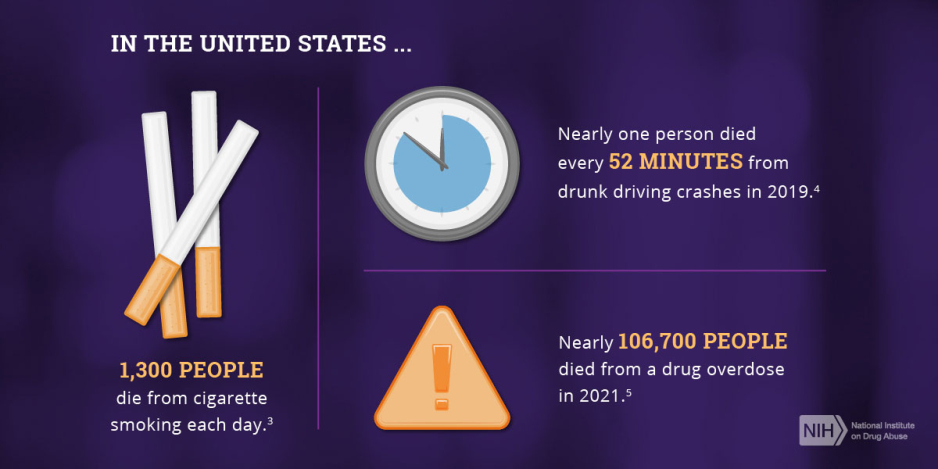
At the National Institute on Drug Abuse (NIDA), our goal is to help people get accurate, science-based information about drugs and health. To help you start a conversation about drugs and health, we’ve compiled teens' 10 most frequently asked questions from more than 118,000 queries we’ve received from young people during National Drug and Alcohol Facts Week®. It’s okay if some of this information is news to you—lots of other people are asking, too!
- 10. Why do people use drugs when they know they might cause problems?
Every day we make choices that affect our health. People take drugs for a lot of different reasons, like to deal with life’s challenges, to escape from reality, to relieve pain, or to try to fit in—just to name a few.
Some people can be aware of the negative effects of drugs on their health and in their life and still struggle to stop using them. This is because repeated drug use can lead to changes in the brain that make it hard to stop using them, even when people want to stop. When this happens, the person is experiencing a medical problem known as substance use disorder. Addiction is a severe form of substance use disorder.
All addictive drugs cause the brain to release the chemical dopamine. Dopamine is usually released after pleasurable and satisfying activities. Dopamine causes the brain to remember rewards, like food and sex, and reinforces the desire to seek them out again. Repeatedly using a drug floods the brain with more dopamine, which can change the way the brain responds to that drug.
With repeated use, a greater quantity of drug is needed to produce the same pleasurable effect. When the drug is not available, people may experience the negative symptoms of withdrawal, which may include stress, anxiety, depression, and sometimes physical symptoms such as sweating, vomiting and pain. Repeated cycles of drug use and withdrawal can disrupt brain function to the extent that people may have difficultly experiencing pleasure in their daily lives. At this point, many people continue drug use to avoid the lows caused by withdrawal rather than seek the highs they once experienced.
Fortunately, treatment can help people with a substance use disorder counteract these disruptive effects and lead healthier lives. The sooner a person receives treatment, the better the chance that they will recover.
Image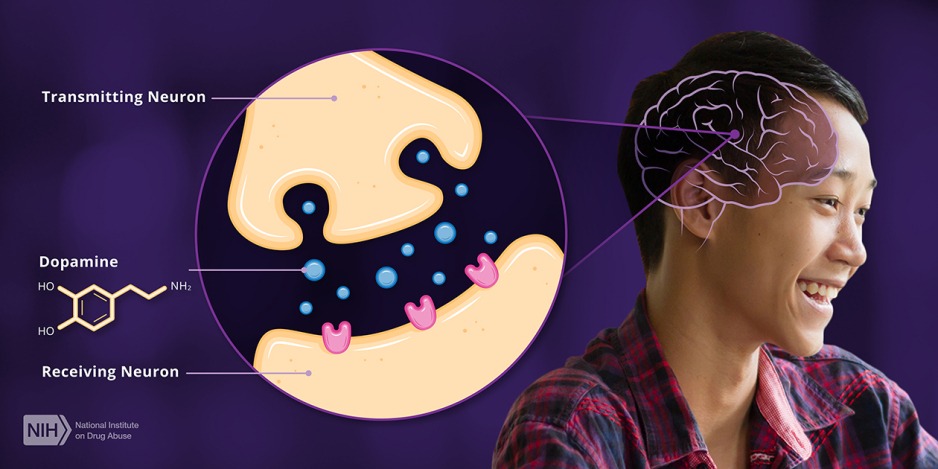
- 9. What are the effects of drugs like Xanax® and Percocet®?
Xanax® and Percocet® are both brand names of prescription drugs. Both can help treat certain medical conditions when used as directed by a doctor, but they have the potential to be misused. They work in the brain in different ways:
Xanax®, or alprazolam, is a prescription depressant that helps produce a calming effect. Many people experience anxiety disorders and have difficulty sleeping, and prescription depressants can help treat these symptoms.
Percocet® is prescribed to treat severe pain from serious injuries or after surgery. It contains the analgesics (pain relievers) acetaminophen (the same drug as in Tylenol®) and oxycodone, which is an opioid analgesic. Opioids affect the brain's reward circuit, causing euphoria (the high), and flooding the brain with the chemical messenger (dopamine) which reinforces the brain to seek out the drug again.
Xanax® and Percocet® can cause severe adverse health effects, including overdose, if taken in large quantities or if taken with certain other drugs. Large doses of acetaminophen in Percocet® can also cause life-threatening liver damage. If you are prescribed these drugs, carefully follow your clinician’s instructions, and do not share them with others.
Image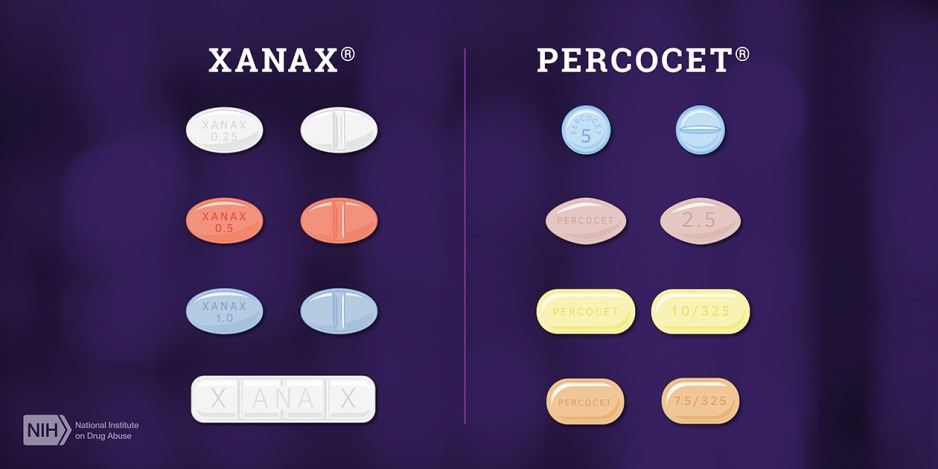 NIDA
NIDA- 8. What are bath salts?
When teens ask us about bath salts, we understand that they’re probably not referring to Epsom salt for a relaxing time in the tub. They’re talking about synthetic cathinones, which are stimulants made in labs. Bath salts and similar drugs cause extreme wakefulness and elevated heart and breathing rates. Many people seek out these drugs because they are viewed as a cheaper substitute for stimulants like methamphetamine and cocaine.
Using bath salts can cause severe intoxication, hallucinations, paranoia, panic attacks, and addiction. Serious health effects including dehydration and kidney problems can also occur. An additional danger of taking these synthetic drugs is that they might contain other substances with their own harmful effects, including life-threatening overdoses.
Bath salts are usually white or brown crystal-like powder that are ingested in several ways, though snorting or injecting these drugs further increases the risk of harmful effects.
Despite their health risks, some of these drugs are sold legally in stores or online in small plastic or foil packages with the words, "Not for human consumption." In addition to "bath salts," synthetic cathinones are sometimes labeled as "plant food," "research chemicals," or "glass cleaner."
Image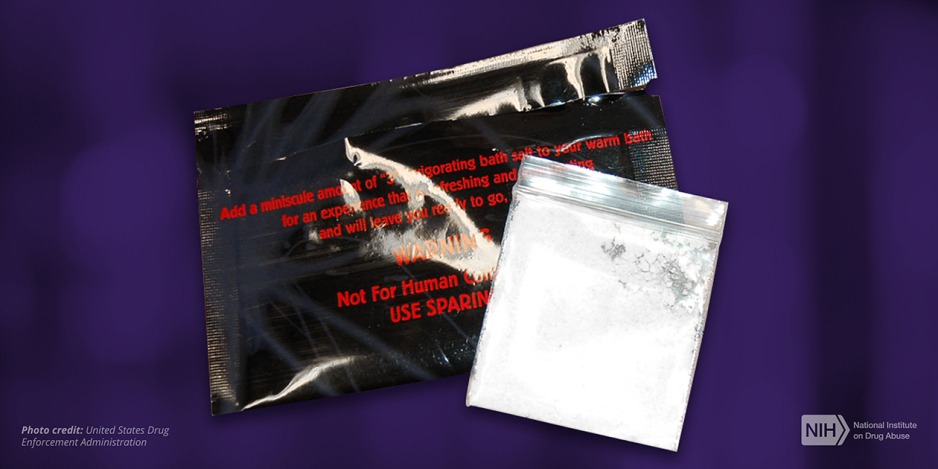 NIDA
NIDA- 7. Can you get addicted to ADHD meds?
Many teens who have been diagnosed with attention-deficit/hyperactivity disorder (ADHD) take prescription stimulants like Adderall® or Ritalin® to help treat their symptoms. When taken as directed, these medications can be helpful and safe, and have a very low risk for addiction. If your doctor prescribes stimulants, it’s important to follow the instructions and to discuss any concerns about addiction or dependence.
Sometimes people who don’t have ADHD take drugs like Adderall® or Ritalin® in an attempt to get high, to stay awake longer, or to stay focused while studying. According to the Monitoring the Future annual survey on teen drug use, there was a significant increase in the misuse of the ADHD medicine Adderall® among 8th graders from 2015 to 2020.
This can be especially harmful because people often take these medications at a higher dose or through a different route than prescribed. Misusing ADHD medications can cause headaches, nausea, feeling anxious, and sleeping problems. Misusing prescription stimulants can also lead to addiction. These drugs can also make you feel paranoid, cause your body temperature to get dangerously high, and make your heart beat too fast. While stimulants may help with a lack of focus in some people, they may diminish other skills (like creative thinking).
Image NIDA
NIDA- 6. Is vaping bad for you even if it’s just flavoring?
It can be. Research shows that many teens and young adults don’t realize that the flavors they use actually can contain nicotine, an addictive compound found in tobacco. Many vapes also contain propylene glycol, glycerin, chemical flavorings, and other compounds with unknown health effects. As a result, people who vape—even just flavoring—may inhale and ingest potentially harmful chemicals.
Recent studies showed that students who had already used any type of e-cigarette by the time they started 9th grade were more likely than others to start smoking cigarettes and other smokable tobacco products within the next year. And we know that cigarette smoking is a leading cause of cancer and other illnesses. According to the Centers for Disease Control and Prevention (CDC), cigarettes cause more than 480,000 premature deaths in the United States each year—from smoking or exposure to secondhand smoke. This represents about 1 in every 5 U.S. deaths, or 1,300 deaths every day.
Other vaping products can also cause harm. In 2020, thousands of people got sick and dozens died from an illness called EVALI, which stands for e-cigarette or vaping-use associated lung injury. Vitamin E acetate, an additive in some THC-containing vaping products, is strongly linked to EVALI. When heated and inhaled, vitamin E acetate can damage the lungs.
Image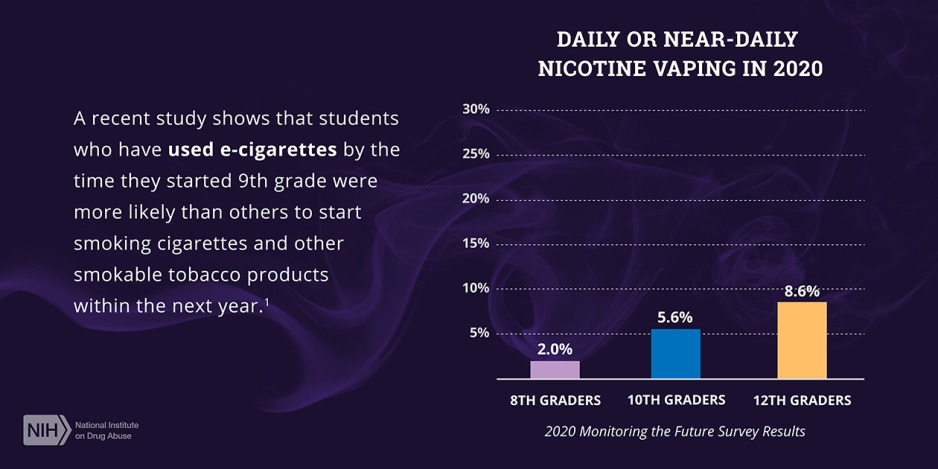 NIDA
NIDA- 5. How can I help someone with a problem stop taking drugs? How can I help if they don't want help?
Supporting a loved one through a struggle with substance use can be difficult for adults and teens alike. This process can be especially complicated when someone is resistant to getting help. While you may not have control over someone else's substance use, support is available to cope with how that substance use may affect you.
The Substance Abuse and Mental Health Services Administration (SAMHSA) operates the National Helpline 1-800-662-HELP (4357). This is a free, confidential, 24/7, 365-day-a-year treatment referral and information service (in English and Spanish). SAMHSA has resources available online for families coping with mental and substance use disorders and also provides a confidential online treatment locator.
If someone is experiencing an overdose, mental health crisis, or another emergency, call 9-1-1.
Image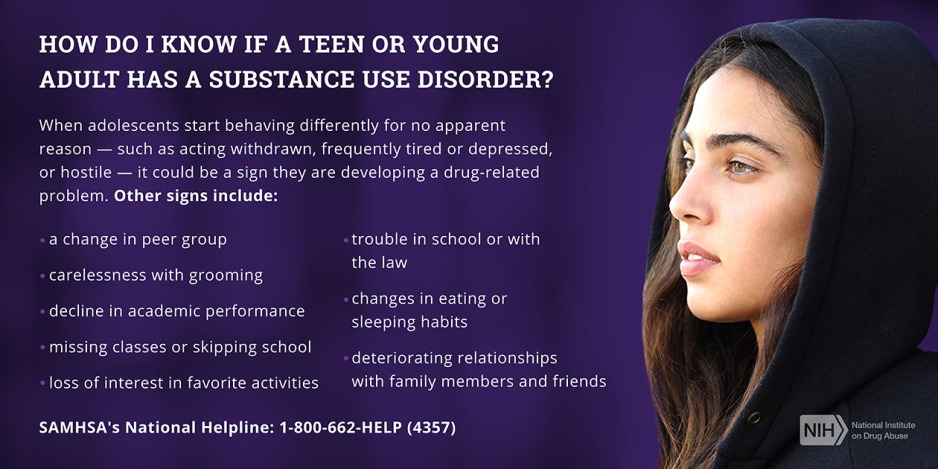 NIDA
NIDA- 4. If a pregnant woman takes drugs/smokes/drinks alcohol, what happens to her baby?
Pregnancy is an important time to maintain or adopt healthy behaviors. Decades of research show exposure to certain substances can be unsafe for the health of the woman and the baby. Many drugs, including opioids, alcohol, and stimulants, have been associated with harm to the developing fetus. Using or being exposed to some substances can increase the risk of miscarriage and can cause migraines, seizures, or high blood pressure in the mother. A 2013 study found the risk of stillbirth was 2 to 3 times greater in women whose blood tests showed exposure to tobacco and about 2 times greater in women whose blood tests showed exposure to cannabis, stimulants, or prescription pain relievers.2 Pregnant women should refrain from drinking alcohol and talk with their health care provider before using any medicines or drugs.
Image NIDA
NIDA- 3. Can marijuana be used as medicine?
Although the medical use of marijuana is legal in many states, the U.S. Food and Drug Administration (FDA) has not determined that the marijuana plant is safe and effective for treating any disease or condition and has not approved it as a medicine.
Although the marijuana plant has not been approved as medicine, the FDA has approved formulations of two of the components of marijuana—THC and CBD—as medicine for specific conditions. THC, which stands for delta-9-tetrahydrocannabinol, is responsible for marijuana’s “high”, the euphoric and addictive effects of the drug. CBD, or cannabidiol, does not produce a high and has not been shown to lead to addiction.
CBD derived from the marijuana plant has been approved for seizures associated with specific disorders, and laboratory-made THC has been approved to help with appetite in people with AIDS and to treat nausea associated with chemotherapy for people with cancer. Although not available in the United States, a combination of plant-derived THC and CBD has been approved in multiple countries to treat some symptoms of multiple sclerosis.
The National Institutes of Health, including NIDA, continue to support research on the potential medical uses of marijuana and its components. Currently, however, marijuana products (including CBD) are being marketed as treatments for many conditions for which there is insufficient or no evidence of their safety or effectiveness.
Image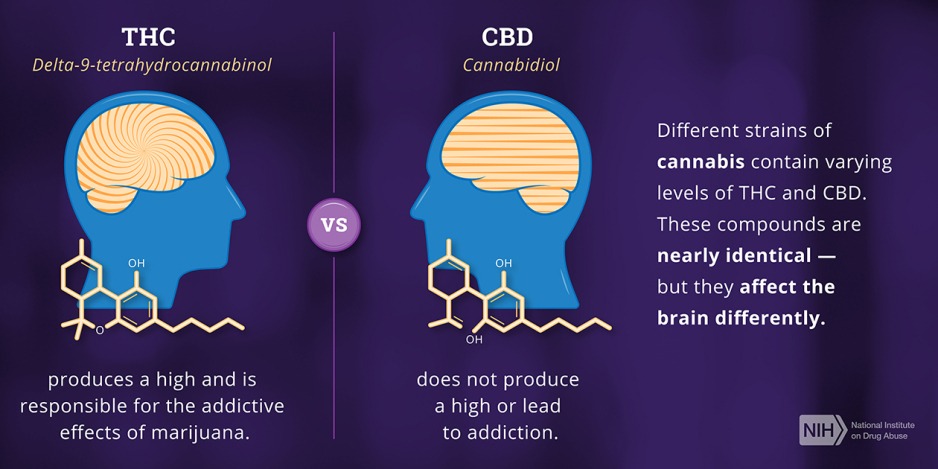 NIDA
NIDA- 2. Which is more habit-forming – smoking cigarettes or vaping nicotine?
Nicotine in any form is highly addictive, and many who start using one form of nicotine transition to another.
NIDA’s 2020 Monitoring the Future survey showed that the number of teens who say they vape nicotine has leveled off but remains high. The number of teens who say they smoked cigarettes in the past month declined significantly since the mid-1990s and is now at or near the lowest it ever has been. Because both smoking and vaping are so addictive, it is helpful to speak with a doctor when trying to quit either. A good strategy is never to start.
Image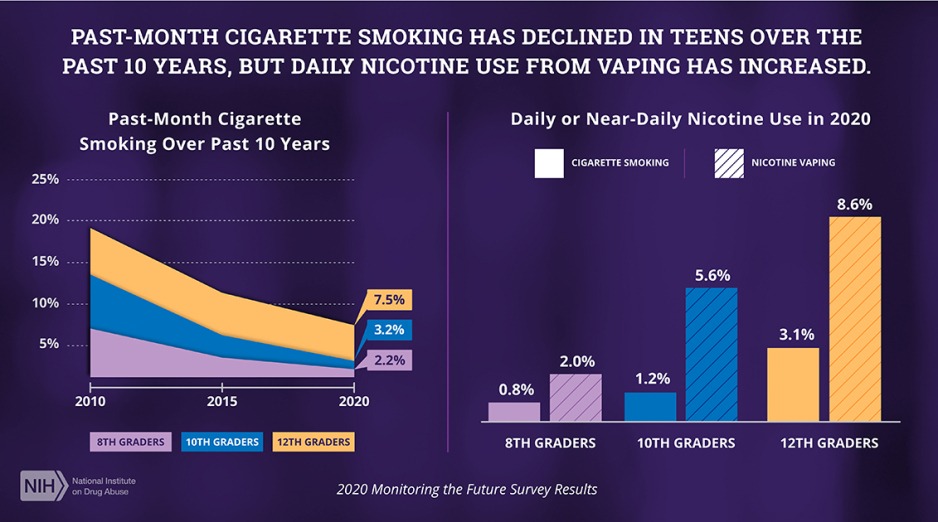 NIDA
NIDAAnd the question we receive most often from teens is …
- 1. What is the worst drug?
It’s only natural to want to know what’s best or worst, good or bad. That’s why we love these types of lists! But in the case of drugs and alcohol, there isn’t a “worst” just as there isn’t a “best” drug.
We don’t define drugs as most or least harmful. All drugs have the potential to produce negative health effects or lead to a dangerous situation in the short or long term. Whether a drug causes a serious health issue—like a life-threatening overdose—can depend on how much a person uses, how they consume it, and other factors.
However, some drugs are so potent that a life-threatening overdose can occur the first time a person uses them. For example, the synthetic opioid fentanyl is 100 times more potent than morphine and 50 times more potent than heroin. Because fentanyl is often mixed with other drugs, such as heroin, cocaine, methamphetamine, and MDMA (Molly), fentanyl may be ingested unknowingly at unknown quantities, which can lead to overdose. Injecting potent drugs can be particularly dangerous because this route delivers the compounds more directly to the brain than ingesting or snorting drugs. Injection also carries the risks of injury and infection.
Similarly, some drugs are more frequently associated with addiction and dependence than others. For example, more than half of people who regularly use cigarettes meet the criteria for a tobacco use disorder, while only about 1 in 11 people who regularly use marijuana (cannabis) meet the criteria for a cannabis use disorder. Certain drugs can have a stronger effect on the brain than others. Research has shown that methamphetamine, in particular, may damage cells and structures within the brain that can cause long-term problems with emotion and memory.
Certain physical or mental illnesses, as well as family health history, also influence someone's chances of developing an addiction or other negative health effects of drug use. Age is an especially important factor when calculating the risks of substance use. Because the brain develops through a person’s mid-twenties, teens and young adults tend to be more vulnerable to negative health effects of many drugs. All of this means certain substances may pose different risks to different people in different situations.
Going by the numbers, determining the deadliest drug also depends on perspective.
In 2021, an estimated 106,699 people died from a drug overdose in the United States. The most common drugs associated with these fatal overdoses were synthetic opioids, including highly potent illicitly made fentanyl.
However, the long-term health effects of cigarette smoking are responsible for more than 480,000 deaths per year. That’s about 1,300 deaths every day.
And alcohol is the substance most frequently involved in deadly car crashes. Nearly one person died every 52 minutes from drunk driving crashes in 2019.
To put it simply, what's the "worst" drug isn't an easy question to answer, and it’s important to understand the risks of any substance. NIDA supports research to help us understand the effect of drugs on the brain, how to prevent people from starting to use drugs, and how to help them if they have substance use disorder.
References:
- Leventhal AM, Strong DR, Kirkpatrick MG, et al. Association of electronic cigarette use with initiation of combustible tobacco product smoking in early adolescence. JAMA. 2015;314(7):700-707. doi:10.1001/jama.2015.8950
- Eunice Kennedy Shriver National Institute of Child Health and Human Development.
https://www.nichd.nih.gov/news/releases/pages/121113-stillbirth-drug-use.aspx. Published December 11, 2013. Accessed January 31, 2018. - Centers for Disease Control and Prevention, Office on Smoking and Health. Smoking and Tobacco Use, Fast Facts.
https://www.cdc.gov/tobacco/data_statistics/fact_sheets/fast_facts/index.htm#:~:text=Cigarette%20smoking%20is%20responsible%20for,or%201%2C300%20deaths%20every%20day.&text= On%20average%2C%20smokers%20die%2010%20years%20earlier%20than%20nonsmokers. - United States Department of Transportation, National Highway Traffic Safety Administration. Risky Driving, Drunk Driving.
https://www.nhtsa.gov/risky-driving/drunk-driving - WONDER. Multiple Cause of Death 1999-2021. Centers for Disease Control and Prevention, National Center on Health Statistics. Released January 2023. Accessed January 2023.

